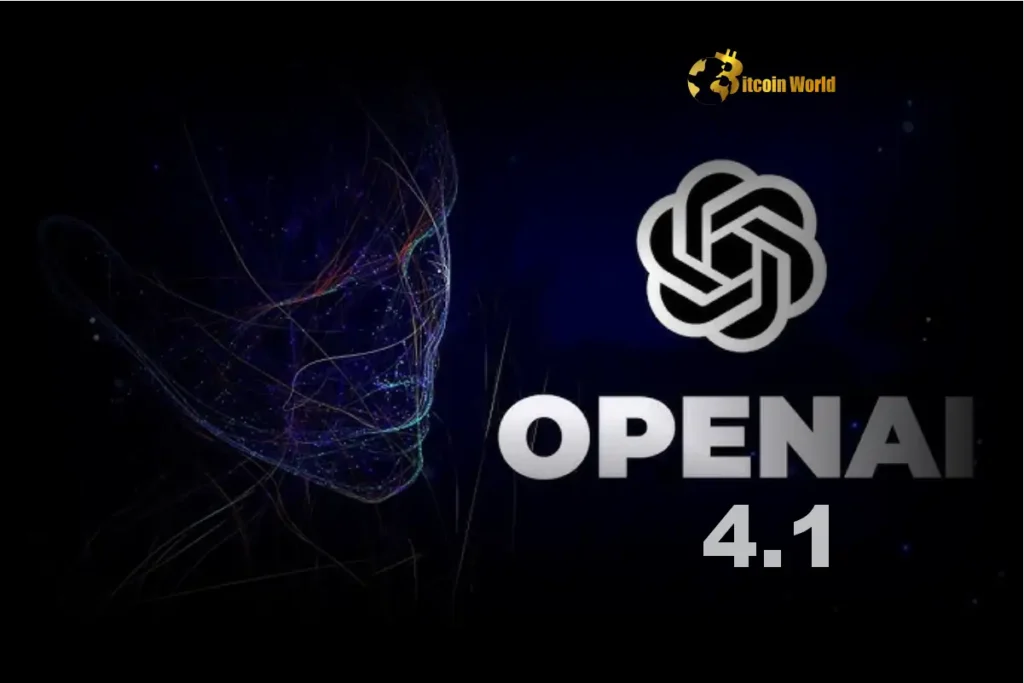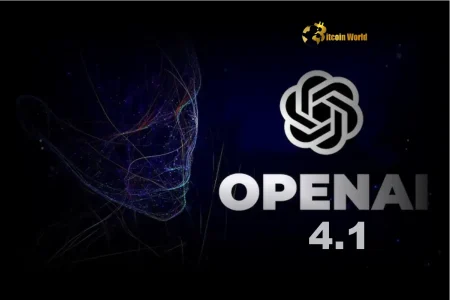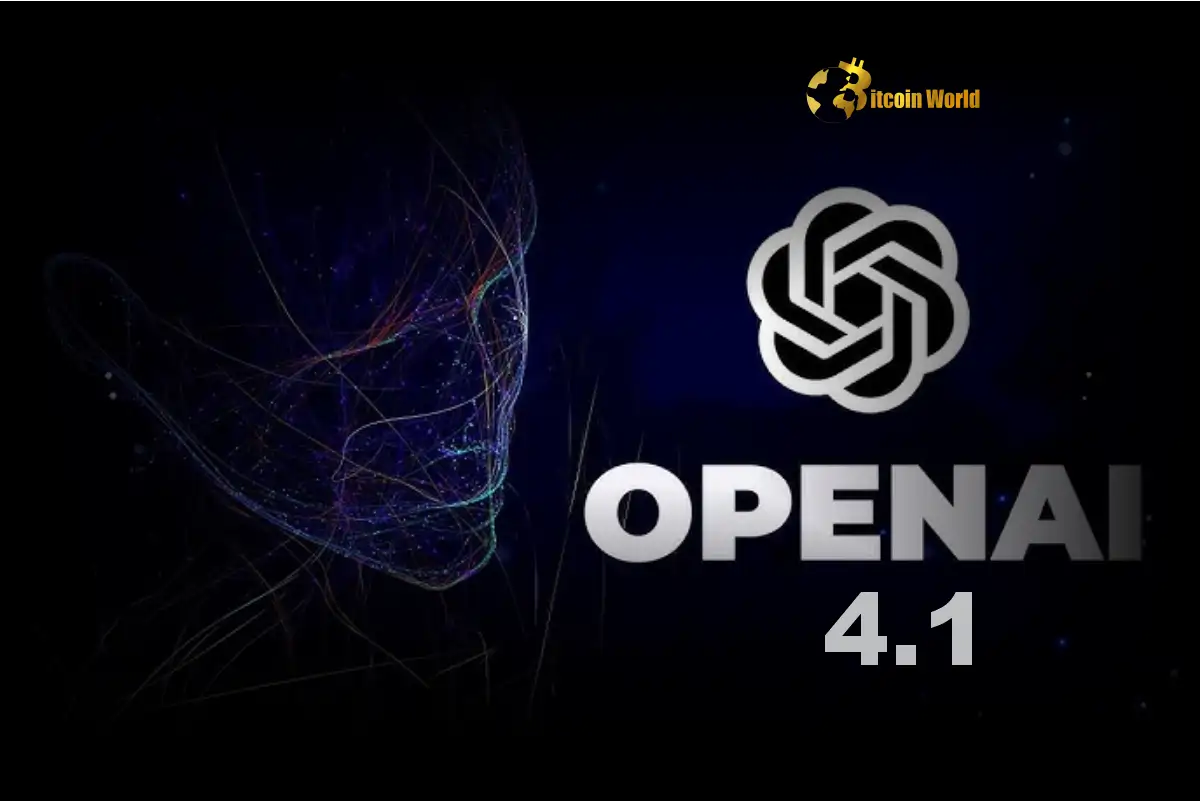GPT-4.1 Models: OpenAI Unleashes Enhanced Capabilities in ChatGPT

BitcoinWorld
GPT-4.1 Models: OpenAI Unleashes Enhanced Capabilities in ChatGPT
In the fast-paced world of technology, artificial intelligence continues to evolve, impacting various digital landscapes. For those tracking advancements that shape the future of digital interaction, a recent announcement from OpenAI is particularly noteworthy. OpenAI, a leader in AI research, has officially brought its advanced GPT-4.1 and GPT-4.1 mini AI models directly into its popular conversational platform, ChatGPT.
This move, announced via a post on X, signifies a direct upgrade for users, integrating models previously available primarily through OpenAI’s developer API. The core focus of these new models appears to be enhancing specific functionalities, particularly for users engaged in software development.
What Do the New GPT-4.1 Models Bring to ChatGPT?
The primary benefit highlighted by OpenAI for the GPT-4.1 models is their enhanced capability in coding and instruction following. This is particularly relevant for software engineers who use ChatGPT as a tool for writing, debugging, or understanding code. OpenAI spokesperson Shaokyi Amdo noted that GPT-4.1 excels in these areas compared to previous iterations like GPT-4o.
Key characteristics of the GPT-4.1 models include:
Improved Coding Performance: GPT-4.1 is designed to be more proficient and accurate when handling coding tasks and following complex instructions.
Faster Processing: While excelling at coding, GPT-4.1 is also reported to be faster than OpenAI’s ‘o-series’ of reasoning models, offering a quicker user experience.
Instruction Following: The models demonstrate better ability to understand and execute multi-step or nuanced instructions.
This makes the GPT-4.1 models a powerful tool for developers seeking efficiency and accuracy in their AI-assisted workflows.
Who Gets Access to GPT-4.1 and GPT-4.1 Mini?
OpenAI is implementing a tiered rollout for the new models within ChatGPT:
The standard GPT-4.1 model is being rolled out to users on ChatGPT Plus, Pro, and Team subscription plans.
The GPT-4.1 mini model is becoming available to a wider audience, accessible by both free and paying users of ChatGPT.
As part of this update, OpenAI is also making a change to the available models. The GPT-4.0 mini model is being removed from ChatGPT for all users, as the new GPT-4.1 mini model is intended to supersede it with improved performance.
Addressing the Initial Safety Concerns Around GPT-4.1
When OpenAI initially launched the GPT-4.1 and GPT-4.1 mini models in April, they were released exclusively through the developer-facing API. At that time, the company faced criticism from some in the AI research community regarding the absence of a detailed safety report accompanying the release. Researchers argued this represented a lowering of transparency standards for new AI models.
OpenAI defended its approach, stating that despite GPT-4.1’s performance gains, it was not classified as a ‘frontier model’. Frontier models, typically the most advanced and potentially impactful AI systems, are subject to more rigorous safety reporting standards. OpenAI’s Head of Safety Systems, Johannes Heidecke, explained that GPT-4.1 did not introduce new modalities or significantly surpass the intelligence of previous frontier models like GPT-4o, meaning the safety considerations were different.
OpenAI’s Steps Towards Greater Transparency in AI Models
Perhaps influenced by the discussions around the GPT-4.1 release and broader calls for accountability, OpenAI has recently committed to increasing transparency regarding its AI models. Earlier on the same day as the ChatGPT update announcement, OpenAI stated it would publish the results of its internal AI model safety evaluations more frequently.
To facilitate this, OpenAI launched a new Safety Evaluations Hub. This dedicated resource will serve as a central point for researchers, policymakers, and the public to access information about OpenAI’s ongoing safety work and evaluation results. This move signals an effort by OpenAI to proactively address concerns and build trust within the AI ecosystem.
The Context: Increased Focus on AI Coding Tools
The release of enhanced AI coding capabilities within ChatGPT comes at a time of heightened activity and interest in AI-powered development tools. Reports suggest OpenAI is in advanced discussions to acquire Windsurf, a prominent AI coding tool, for a substantial sum. Simultaneously, other tech giants are also enhancing their offerings; Google recently updated its Gemini chatbot to integrate more seamlessly with GitHub projects.
This competitive landscape underscores the growing importance of AI in streamlining and augmenting the software development process, making the improved AI coding features in GPT-4.1 particularly timely.
Conclusion: A Step Forward for ChatGPT Users
The integration of the GPT-4.1 and GPT-4.1 mini AI models into ChatGPT represents a significant update, particularly benefiting users focused on development and coding tasks. The enhanced speed and instruction following, coupled with the broader availability of the mini version, make ChatGPT a more capable tool for a wider audience. While the initial API release sparked discussions about safety reporting, OpenAI’s subsequent launch of a transparency hub indicates a response to these concerns and a commitment to sharing more about their safety evaluations moving forward. This update positions ChatGPT with more powerful AI coding features within a competitive and rapidly evolving market.
To learn more about the latest AI model trends, explore our article on key developments shaping AI features.
This post GPT-4.1 Models: OpenAI Unleashes Enhanced Capabilities in ChatGPT first appeared on BitcoinWorld and is written by Editorial Team












